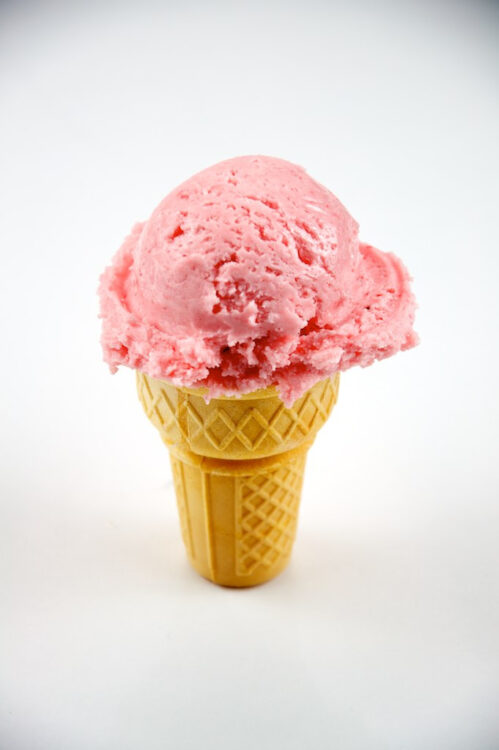Thirty-one pints of ice cream are consumed by the average American each year, making up the 1.3 billion gallons of ice cream U.S. manufacturers churned out in 2021, according to the International Dairy Foods Association. The global ice cream market shows no signs of slowing down with a nearly 50% estimated growth in worth from 2021 to 2029 according to Fortune Business Insights. How have ice cream manufacturers capitalized on and created such high demand for a dessert that dates back to ancient times? The answer lies in fundamental chemistry principles.
The key to smooth, high-quality ice cream is heat transfer and crystallization, two aspects that need to be considered throughout the entire ice cream making process. Manufacturers first blend ingredients to form a mix that serves as a base for creating different ice cream flavors. Next, they heat the mix for a brief period of time to kill pathogens, then cool it and add flavors. When the mix is adequately cooled, it is transferred to a scraped surface freezer, a cooling container with blades that scrape the walls. The ice cream mix becomes colder as it transfers heat to the walls of the container. At the same time, ice crystals that form along the below-freezing walls are dispersed by the scraper blades towards the slightly warmer center of the container. This breaks and melts ice crystals to prevent them from growing too large or concentrating too heavily in one area of the mix. When the temperature of the mix is cold enough, it is removed from the scraped surface freezer and packaged into another container for the hardening process. As one might expect, the hardening process increases the percentage of solid ice cream by cooling it to lower temperatures so the ice cream holds its shape. After at least 6 hours in the hardening step, the ice cream is ready to be distributed.
The initial freezing and scraping process is a particularly critical phase for ice cream machines. Since ice crystals are formed during this step, it controls the efficiency of heat transfer and crystallization. According to Trends in Food Science and Technology, if the mix cools slowly and comes out at a higher temperature, it will contain fewer ice crystals than a mix that cools quickly and comes out at a lower temperature, because the ice crystals have more time to lump together. The problem with fewer ice crystals is that they make up less volume of the mix and have more room to grow during the hardening step, resulting in coarse and grainy ice cream. Therefore, when making ice cream, it’s crucial that the ice cream base and freezing container are as cold as functionally possible to ensure the base will reach an adequately low temperature in a short amount of time. Slow churning ice cream overcomes this issue by using a low-temperature ice cream tool called an extruder that reduces the particle size of crystals further than scraper blades. Although the average person might not have access to a low-temperature extruder for home ice cream making, there are additional ways to control ice cream quality.
Assuming that the freezing container and ice cream mix are cold enough, another important factor that affects ice cream quality is the ingredients. Advanced Dairy Chemistry suggests that ice cream bases be composed of 10% to 16% fats, 14% to 16% sweeteners, 9% to 12% milk solids, 60% to 64% water, 0.1% to 0.2% stabilizers, and 0.1% to 0.2% emulsifiers. In practice, this could look like heavy cream or coconut cream for fat; table sugar for sweetener; whole or non-dairy milk making up the milk solids and water content; polysaccharides such as locust bean gum or carrageenan for stabilizers; and mono- and diglycerides, the proteins in milk, or egg yolks — which have an emulsifier called lecithin — as emulsifiers. Their specific roles include fats taking up space to prevent growth of ice crystals during the hardening process, sweeteners depressing the freezing point of ice cream, stabilizers increasing the viscosity of ice cream by binding to water molecules, and emulsifiers coating fat molecules to more easily combine with water molecules. Together, these ingredients and the incorporation of air into the mix prevent ice cream from freezing into a block of ice.
Armed with knowledge of the roles ice cream ingredients play, someone can more readily create, modify, or troubleshoot existing ice cream recipes. For example, to make dairy-free ice cream, they could substitute coconut cream and any non-dairy milk for heavy cream and whole milk. Keeping in mind that non-dairy milks might have higher water content than dairy milk, someone could add oil as additional fat to the base ensuring ice crystal growth is minimized. In another scenario, perhaps someone finds that their ice cream is too hard when stored at normal freezer temperatures. Adding more sweetener to the base or using a sweetener with a lower freezing point could reduce the freezing point of the base and therefore prevent the ice cream from becoming too frozen at cold temperatures. An ice cream that is too soupy could benefit from a stabilizer since stabilizers act like a sponge for water molecules, while an ice cream that is thick but has noticeable bits of ice throughout could benefit from an emulsifier to “hide” the ice by bringing the fat globules and ice crystals closer together.
With the correct application and balance of ingredients, it is possible to account for a wide range of ice cream issues, including those that result from dietary requirements such as sugar free, dairy free, vegan, and paleo. The use of fundamental chemistry in creating ice cream that meets these dietary requirements has led to an ever-expanding market and is the reason that anyone can enjoy ice cream today.
Sources:
Advanced Dairy Chemistry (2006). DOI: 10.1007/0-387-28813-9_12
Trends in Food Science and Technology (1996). DOI: 10.1016/0924-2244(96)10033-9
Image courtesy of Wikimedia Commons

